Related Research Articles
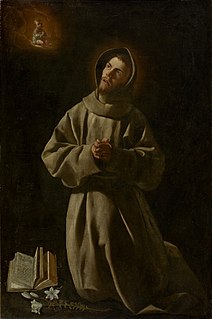
Anthony of Padua or Anthony of Lisbon was a Portuguese Catholic priest and friar of the Franciscan Order. He was born and raised by a wealthy family in Lisbon, Portugal, and died in Padua, Italy. Noted by his contemporaries for his powerful preaching, expert knowledge of scripture, and undying love and devotion to the poor and the sick, he was one of the most quickly canonized saints in church history, being canonized less than a year after his death. He was proclaimed a Doctor of the Church by Pope Pius XII on 16 January 1946.

Chaitanya Mahaprabhu was a 15th-century Indian saint who is considered to be the combined avatar of Radha and Krishna by his disciples and various scriptures. Chaitanya Mahaprabhu's mode of worshipping Krishna with ecstatic song and dance had a profound effect on Vaishnavism in Bengal. He was also the chief proponent of the Vedantic philosophy of Achintya Bheda Abheda Tattva. Mahaprabhu founded Gaudiya Vaishnavism. He expounded Bhakti yoga and popularized the chanting of the Hare Krishna Maha-mantra. He composed the Shikshashtakam.

Gaudiya Vaishnavism, also known as Chaitanya Vaishnavism, the Bengali, Chaitanya or Gaudiya Sampradaya, Chaitanyaism, and Gaura Dharma.</ref> is a Vaishnava Hindu religious movement inspired by Chaitanya Mahaprabhu (1486–1534) in India. "Gaudiya" refers to the Gaura or Gauḍa region of Bengal, with Vaishnavism meaning "the worship of Vishnu". Specifically, it is part of Krishnaism—Krishna-centric Vaishnavite traditions.
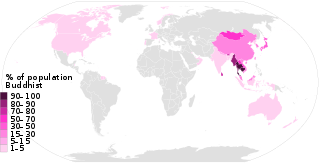
This list of Buddhism by country shows the distribution of the Buddhist religion, practiced by about 535 million people as of the 2010s, representing 7% to 8% of the world's total population.

Hinduism is a minority religion in Australia consisting of more than 684,002 followers, making up 2.7% of the population as of the 2021 census. Hinduism is the fastest growing religion in Australia mostly through immigration. Hinduism is also one of the most youthful religions in Australia, with 34% and 66% of Hindus being under the age of 14 and 34 respectively.

Ramakrishna Math is the administrative legal organization of the Ramakrishna Order, considered part of the Hindu reform movements. It was set up by sanyasin disciples of Ramakrishna Paramhansa headed by Swami Vivekananda at Baranagar Math in Baranagar, a place near Calcutta, in 1886. India. The headquarters of Ramakrishna Math and its twin organisation, Ramakrishna Mission is at Belur Math.

Bishnoi is a Hindu community found in the Western Thar Desert and northern states of India. They follow a set of 29 principles/commandments given by Guru Jambheshwar (1451-1536). They are a sub-sect of the Vaishnav Sampraday. As of 2019, there are an estimated 600,000 followers of Bishnoi Panth residing in north and central India. Shree Guru Jambheshwar founded the sect at Samrathal Dhora in 1485 and his teachings, comprising 120 shabads, are known as Shabadwani. He preached for the next 51 years, travelling across India. The preaching of Guru Jambhoji inspires his followers as well as the environmental protectors. Bishnoi sect admitted members from a variety of castes including Jats, Bania, Charans, Rajputs, Brahmins, and Ahirs.
Freedom of religion in Sri Lanka is a protected right under Chapter II, Article 9 of the constitution of Sri Lanka. This applies to all religions, though Buddhism is given the foremost place under the 1978 Republican Constitution. Sri Lanka is regarded by its Supreme Court as being a secular state.

The Gaudiya Math is a Gaudiya Vaishnava matha formed on 6 September 1920, about 30 months after Bhaktisiddhanta Sarasvati took sannyasa, the renounced order of life. On 7 March 1918, the same day he took sannyasa, he established the Sri Chaitanya Math in Mayapura in West Bengal, later recognised as the parent body of all the Gaudiya Math branches. Its purpose was to spread Gaudiya Vaishnavism, the philosophy of the medieval Vaisnava saint Chaitanya Mahaprabhu, through preaching and publishing.

The culture of Sri Lanka mixes modern elements with traditional aspects and is known for its regional diversity. Sri Lankan culture has long been influenced by the heritage of Theravada Buddhism passed on from India, and the religion's legacy is particularly strong in Sri Lanka's southern and central regions. South Indian cultural influences are especially pronounced in the northernmost reaches of the country. The history of colonial occupation has also left a mark on Sri Lanka's identity, with Portuguese, Dutch, and British elements having intermingled with various traditional facets of Sri Lankan culture. Additionally, Indonesian culture has also influenced certain aspects of Sri Lankan culture. Culturally, Sri Lanka possesses strong links to both India and Southeast Asia.
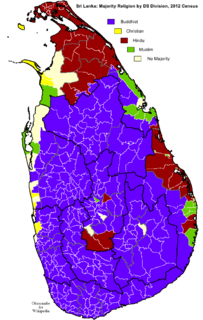
Sri Lanka's population practices a variety of religions. As of the 2012 census, 70.2% of Sri Lankans were Buddhists, 12.6% were Hindus, 9.7% were Muslims, 7.4% were Christians. Buddhism is declared as the State religion of Sri Lanka and has been given special privileges in the Sri Lankan constitution such as the government is bound for protection and fostering of Buddhist Dharma throughout the nation. However, the constitution also provides for freedom of religion and right to equality among all its citizens. In 2008 Sri Lanka was the third most religious country in the world according to a Gallup poll, with 99% of Sri Lankans saying religion is an important part of their daily life.

Tissa, later Devanampiya Tissa, was one of the earliest kings of Sri Lanka based at the ancient capital of Anuradhapura from 247 BC to 207 BC. His reign was notable for the arrival of Buddhism in Sri Lanka under the aegis of the Mauryan Emperor Ashoka the Great. The primary source for his reign is the Mahavamsa, which in turn is based on the more ancient Dipavamsa.
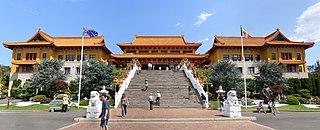
In Australia, Buddhism is a minority religion. According to the 2016 census, 2.4 percent of the total population of Australia identified as Buddhist. It was also the fastest-growing religion by percentage, having increased its number of adherents by 79 percent between the 1996 and 2001 censuses. The highest percentage of Buddhists in Australia is present in Christmas Island, where Buddhists constitute 18.1% of the total population according to the 2016 Census. Buddhism is the fourth largest religion in the country after Christianity, Islam and Hinduism.

Nellaiappar Temple corridor is a Hindu temple dedicated to the deity Shiva, located in Tirunelveli, a city in the South Indian state of Tamil Nadu. Shiva is worshipped as Nellaiappar represented by the lingam and his consort Parvati is depicted as Kanthimathi Amman. The temple is located on the northern banks of Thamirabarani River in Tirunelveli district. The presiding deity is revered in the 7th century Tamil Saiva canonical work, the Tevaram, written by Tamil saint poets known as the nayanmars and classified as Paadal Petra Sthalam.

Christianity in Asia has its roots in the very inception of Christianity, which originated from the life and teachings of Jesus in 1st-century Roman Judea. Christianity then spread through the missionary work of his apostles, first in the Levant and taking roots in the major cities such as Jerusalem and Antioch. According to tradition, further eastward expansion occurred via the preaching of Thomas the Apostle, who established Christianity in the Parthian Empire (Iran) and India. The very First Ecumenical Council was held in the city of Nicaea in Asia Minor (325). The first nations to adopt Christianity as a state religion were Armenia in 301 and Georgia in 327. By the 4th century, Christianity became the dominant religion in all Asian provinces of the Eastern Roman Empire.
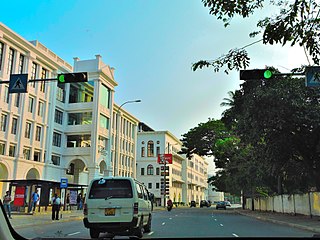
Cinnamon Gardens is an affluent neighbourhood in Colombo, Sri Lanka located 3 kilometers south-east from Colombo's centre. Cinnamon Gardens is named from the former cinnamon plantation in this area. In the year 1789, there were 289 acres (1.17 km2) of cinnamon trees in the gardens.

Ezequiél Moreno y Díaz was a member of the Order of Augustinian Recollects and now venerated as a saint in the Catholic Church. He was born on April 9, 1848, in Alfaro, La Rioja, Spain and later served as a missionary to the Philippines. He also became the Bishop of Pinara and later of Pasto, in Colombia.
Shirdi Sai Baba Temple is a Hindu temple located in the neighbourhood of Mylapore in Chennai, India. It is dedicated to the Indian saint Sai Baba of Shirdi.
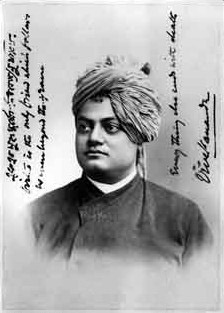
"Buddhism, the Fulfilment of Hinduism" is a lecture delivered by Indian Hindu monk and expounder Swami Vivekananda on 26 September 1893 at the Parliament of the World's Religions in Chicago. In this lecture, he expressed his opinion that "Buddhism was the fulfilment of Hinduism."
The Christian Congregation is a non-denominational fellowship of assemblies with roots in the Italian Pentecostal revival in Chicago, which began in 1907.
References
- ↑ Amarakosha (2.7.41–42)
- ↑ Smritokotha "Archived copy". Archived from the original on 2015-06-10. Retrieved 2013-11-16.
{{cite web}}: CS1 maint: archived copy as title (link) - ↑ "Namassej Namo Samaj".
- ↑ Brodd, Jeffrey (2003). World Religions. Winona, MN: Saint Mary's Press. ISBN 978-0-88489-725-5.
- ↑ J. H. Philpot (1897). Sacred Tree Or the Tree in Religion and Myth. ISBN 9780766129399.[ dead link ]